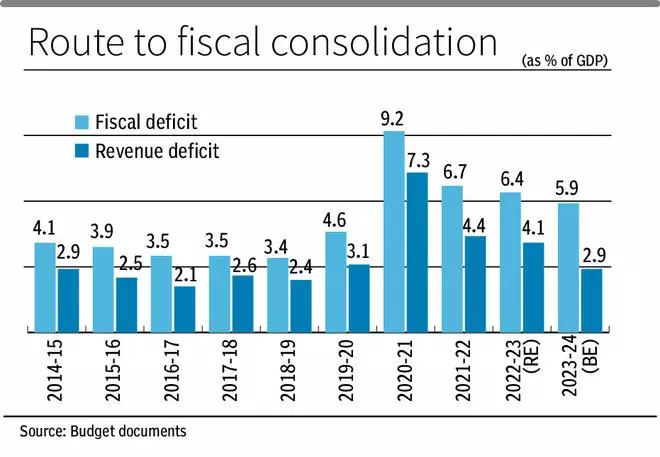
Interim budget-cum-vote on account is likely to peg fiscal deficit for FY24-25 at 5.3-5.4 per cent of GDP (Gross Domestic Products), sources in the government have said. This is possible through higher collection of taxes and cuts in revenue expenditure.

Though the government is hopeful of meeting the fiscal deficit target of 5.9 per cent for the current fiscal, contraction in nominal growth, as projected in the first advance estimate has cast a doubt on this probability. Revised estimate of fiscal deficit will be part of the interim budget.
Fiscal deficit is the difference between income and expenditure of the government. Finance Minister Nirmala Sitharaman will present the interim budget on February 1.
Lowering the target for fiscal deficit is critical for achieving the 4.5 per cent target by FY25-26. While announcing the budget for the current fiscal, the government did not outline any medium term fiscal deficit target citing continued global uncertainty. Instead, as announced in the Budget speech for FY21-22, the government would continue on the broad path of fiscal consolidation to reach a fiscal deficit-to-GDP ratio below 4.5 per cent by FY25-26. In line with this commitment, the central government attained the lower levels of fiscal deficit-to-GDP projected for FY21-22 and FY22-23, the ‘Statements of Fiscal Policy as required under the Fiscal Responsibility and Budget Management Act, 2003’ said.
Aditi Nayar, Chief Economist with ICRA said that with the assumption of a sharper expansion in revenue receipts (9.5 per cent) compared to revenue expenditure (3.9 per cent), the revenue deficit is expected to entail a substantial correction to ₹7.9-lakh crore (2.4 per cent of ICRA’s GDP estimate) in FY25 from the ₹9 lakh crore (3 per cent of GDP) projected for FY2024.
“Taking into account a modest target for disinvestment receipts and a 10 per cent expansion in capex, ICRA expects the GoI to target a fiscal deficit of 5.3 per cent of GDP in FY25, midway through the expected print of 6 per cent in FY24 and the medium-term target of 4.5 per cent for FY26,” she said.
Such a number would mean an absolute fiscal deficit figure of ₹17.1 lakh crore during the next fiscal as against the estimated ₹17.9 lakh crore of current fiscal. While the sharp slowdown in capex growth would weigh on the pace of GDP expansion, ICRA believes that a number higher than this would impinge on the GoI’s ability to bridge half the required consolidation in the coming fiscal.
“As per ICRA’s estimates, every 10 bps of expansion in the fiscal deficit-to-GDP ratio would allow for additional capex of ₹32,400 crore. However, this would make the task at hand in FY26 more challenging,” Nayar said.
As far as current fiscal is concerned, first advance estimate has lowered nominal GDP to 8.9 per cent. Considering fiscal deficit at the end of November at at ₹9.06 lakh crore or 50.7 per cent of BE and revised GDP number, business as usual is likely to take deficit to little over 6 per cent. However, according to SBI research report, if the government curtails spending by over ₹37,000 crore, then 5.9 per cent target could be achieved.
Published on January 11, 2024

Comments
Comments have to be in English, and in full sentences. They cannot be abusive or personal. Please abide by our community guidelines for posting your comments.
We have migrated to a new commenting platform. If you are already a registered user of TheHindu Businessline and logged in, you may continue to engage with our articles. If you do not have an account please register and login to post comments. Users can access their older comments by logging into their accounts on Vuukle.